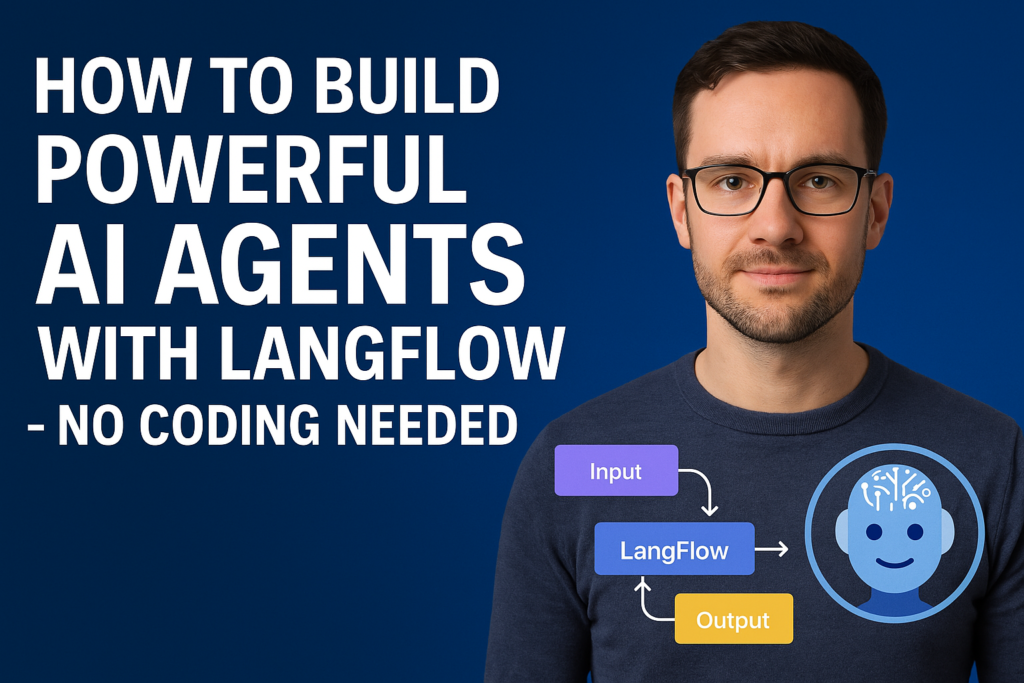How to Build Powerful AI Agents with Langflow – No Coding Needed

Introduction
In 2025, AI agents are more than a buzzword – they’re the core of innovation across OpenAI, Anthropic, and startups like Truth Terminal. But here’s the twist: building agents doesn’t have to be complicated or code-heavy. Enter Langflow – a no-code platform where anyone can build workflows and intelligent agents visually.
This guide will explain what Langflow is, the difference between workflows and agents, and how to build both without writing a single line of Python.
1. What Is Langflow?
Langflow is a visual programming tool that lets you build LLM-powered applications like agents, chatbots, and intelligent workflows – all without needing to code.
With Langflow, you can:
- Create prompt-based automations
- Connect APIs and tools visually
- Build flexible, intelligent agents
- Prototype quickly using drag-and-drop blocks
It’s ideal for developers and non-techies alike.
2. Agents vs Workflows: What’s the Difference?
Most people use these terms interchangeably. But they are not the same.
Workflows:
- Static and predictable
- Follow a pre-defined path
- Great for repetitive tasks (e.g., script writing, blog generation)
Agents:
- Dynamic and adaptive
- Make decisions based on inputs
- Example: a trading agent that adjusts strategies in real-time
Anthropic says it best: Workflows follow instructions, agents reason and adapt.
3. Key Features of Langflow
- Basic Prompting: Simple input > response setups
- RAG (Retrieval-Augmented Generation): Pull data from external sources for better accuracy
- Agents: Run logic-heavy, decision-making systems
- Visual Interface: Drag-and-drop UI for building blocks like prompts, AI models, APIs, and outputs
- Integration with OpenAI, Pinecone, and more
4. How to Build a Chatbot in Langflow
Here’s a simple example to summarize articles using Langflow:
Steps:
- Go to langflow.org and sign in
- Click Build New Flow
- Select Basic Prompting
- Add:
- Input Block (user types a query)
- Prompt Block (e.g., “Summarize this article”)
- AI Block (connect with OpenAI API)
- Output Block (show the result)
- Click Run and paste your content to test
Boom – you just built a functioning summarization bot.
5. Creating an SEO Agent in Langflow
What if your agent could generate keywords and create content? Here’s how:
Steps:
- Select the SEO Keyword Generator template
- Add an Input Block for the user’s website or offer
- Connect it to:
- Prompt block (to analyze and generate keywords)
- AI block (connected to OpenAI or your preferred LLM)
- Add another AI block with a new prompt to generate blog content from keywords
- Finally, attach an Output Block to display the full result
Within minutes, your SEO agent can:
- Analyze a business
- Suggest relevant keywords
- Write a complete SEO-optimized blog post
6. Creating a Stock Market Research Agent
Langflow has a Sequential Task Agent template that works perfectly here. It includes:
- Research tools
- Financial analysis modules
- A built-in LLM search engine (Tavily)
Steps:
- Select the Sequential Task template
- Enter a stock name like “Tesla” or “AAPL”
- Connect AI and search engine nodes
- Click Run
You’ll get real-time financial summaries with charts, analysis, and even news headlines – all automatically compiled.
7. Final Thoughts: What You Can Build Next
With Langflow, the possibilities are endless:
- Build a resume screening agent
- Automate lead qualification
- Launch a customer service chatbot
- Build a marketing assistant that repurposes content
And the best part? You don’t need a tech background. If you can drag, drop, and think logically – you can build an agent.
Start simple. Test often. And scale your systems with AI, fast.
FAQs
Q1: Is Langflow completely no-code? Yes. You don’t need to write any code to build agents or workflows. Just use blocks and connect them visually.
Q2: What’s the difference between an agent and a workflow? Agents adapt and reason. Workflows follow a fixed path. Agents are ideal for dynamic tasks, workflows for repetitive ones.
Q3: Can I integrate Langflow with other tools? Yes. Langflow supports API connections, OpenAI, Pinecone, Tavily, and other external services.
Q4: How do I host the agents I build? You can run them inside Langflow or export them depending on your deployment preference.
Q5: Is Langflow free to use? Yes. There’s a free plan to get started. You’ll only need API keys for LLMs (e.g., OpenAI).